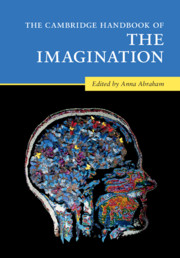Book contents
- The Cambridge Handbook of the Imagination
- The Cambridge Handbook of the Imagination
- Copyright page
- Dedication
- Contents
- Figures
- Contributors
- Acknowledgments
- 1 Surveying the Imagination Landscape
- Part I Theoretical Perspectives on the Imagination
- Part II Imagery-Based Forms of the Imagination
- Part III Intentionality-Based Forms of the Imagination
- Part IV Novel Combinatorial Forms of the Imagination
- 27 On the Interaction Between Episodic and Semantic Representations – Constructing a Unified Account of Imagination
- 28 How Imagination Supports Narrative Experiences for Textual, Audiovisual, and Interactive Narratives
- 29 Development of the Fantasy-Reality Distinction
- 30 Imagining the Real: Buddhist Paths to Wholeness in Tibet
- 31 Hypothetical Thinking
- 32 The Counterfactual Imagination: The Impact of Alternatives to Reality on Morality
- 33 A Look Back at Pioneering Theories of the Creative Brain
- Part V Phenomenology-Based Forms of the Imagination
- Part VI Altered States of the Imagination
- Name Index
- Subject Index
- References
28 - How Imagination Supports Narrative Experiences for Textual, Audiovisual, and Interactive Narratives
from Part IV - Novel Combinatorial Forms of the Imagination
Published online by Cambridge University Press: 26 May 2020
- The Cambridge Handbook of the Imagination
- The Cambridge Handbook of the Imagination
- Copyright page
- Dedication
- Contents
- Figures
- Contributors
- Acknowledgments
- 1 Surveying the Imagination Landscape
- Part I Theoretical Perspectives on the Imagination
- Part II Imagery-Based Forms of the Imagination
- Part III Intentionality-Based Forms of the Imagination
- Part IV Novel Combinatorial Forms of the Imagination
- 27 On the Interaction Between Episodic and Semantic Representations – Constructing a Unified Account of Imagination
- 28 How Imagination Supports Narrative Experiences for Textual, Audiovisual, and Interactive Narratives
- 29 Development of the Fantasy-Reality Distinction
- 30 Imagining the Real: Buddhist Paths to Wholeness in Tibet
- 31 Hypothetical Thinking
- 32 The Counterfactual Imagination: The Impact of Alternatives to Reality on Morality
- 33 A Look Back at Pioneering Theories of the Creative Brain
- Part V Phenomenology-Based Forms of the Imagination
- Part VI Altered States of the Imagination
- Name Index
- Subject Index
- References
Summary
Narrative fiction is a major component of entertainment and culture, comprising books, television, movies, and video games. Our comprehension of these narratives is predicated in part on the imagination, which allows us to simulate fictional events, characters, and worlds. Beyond basic comprehension, the imagination also enables us to generate personalized and unique interpretations of a narrative, effectively allowing us to co-create narratives alongside the author. In this chapter, we discuss the ways in which imagination is used to understand fictional stories across a variety of mediums. We begin with a discussion of mental models, exploring how we use the imagination to translate narrative cues, such as words on a page, into complex and elaborate mental representations. Next, we discuss how the imagination encourages narrative engagement, by allowing us to feel physically transported into fictional worlds. Following that, we examine how the imagination is used to personalize narrative comprehension, through interpreting ambiguous or auxiliary narrative content and through incorporating past personal experiences and current beliefs into the narrative. Finally, we close with a discussion of how modern interactive media may uniquely engage our imagination by providing audiences with the freedom to create their own narratives.
Keywords
- Type
- Chapter
- Information
- The Cambridge Handbook of the Imagination , pp. 466 - 478Publisher: Cambridge University PressPrint publication year: 2020
References
- 4
- Cited by



